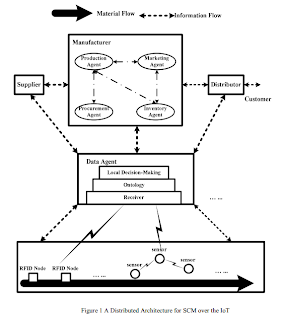Internet of Things (IOT) is a term first used in 1999 which
essentially “describe a system where the Internet is connected
to the physical world objects via ubiquitous sensors” (Internet of
Things)
and for which RFID technology is considered the driver of the whole process
at the moment. The human object interaction scenarios such as turning on the microwave
oven or the air conditioner from hundreds of miles of distance or getting real-time
doctor’s advice on the blood sugar levels across the continents are a powerful
inspiration for supply chain managers.
The brief definition of IOT is here:
SCM connects business to customers, uniting many activities
such as planning, coordinating and controlling of raw materials, parts and
finished goods. While volatile demand is challenging the manufacturers,
increasing competition is also dictating them to get involved with companies in
the whole network for which IOT solutions offer better incentives.
Supply chain
visibility
A study conducted by Forrester Consulting reveals that by
the implementation of IOT solutions supply chain visibility is the most desired
outcome for the companies. Following graph shows other areas of interest, and it
is interesting to note that there is good percentage of companies which are ailing
to use such solutions for other purposes like better labor utilization and
security and surveillance.
Image 2
Mostly, traditional SCM systems receive manually collected
data for the processing decisions in subsystems but IOT based systems’ distinction
will be that they will collect the data automatically. The humongous data
collected from various sensors to improve the effectiveness and efficiency of a
SC network also emphasizes the techniques of efficient data processing. (Lou Ping, 2011) proposes the following
distributed and multi-agent architecture that may suits this requirement.
Image 1
The technology components that are required to implement
Internet of Things solution are following (Building Value from Visibility, 2012)
|
Component
|
Description
|
|
Services
|
Systems integrator and services organizations provide
integration and solution implementation services for IOT projects.
|
|
Software
|
Middleware and application infrastructure vendors provide
information for analytical engines regarding IoT endpoints and enable
vertical market solutions.
|
|
Hardware
|
GPS chips, RFID sensors, actuators, and embedded and external
hardware devices capture location and status information.
|
|
Network
|
Network access, satellite, and transport infrastructure vendors
provide the network connectivity that underlies IoT solutions.
|
|
Analytics solutions
|
Business intelligence and analytical software solutions such as
data mining and predictive analytics, video image analysis, pattern
recognition, and artificial intelligence algorithms determine whether to act
on or ignore a pattern.
|
IOT base solutions are in their early stage of adoption but
there is clear indication that majority of organizations will be investing in
this area in coming 3-5 years. IOT solution provides a better management of
fixed assets. For years systems has focused on security and loss prevention
needs but now increased interest in IOT solutions is due to its ability to give
valuable information about plant, equipment and people using relatively inexpensive devices. It
maximizes the utilization of the assets and minimizes the need to lease or
acquire more plant by monitoring customer and supplier transactions and
alerting about demand and inventory levels, making inventory deployment
efficient.
In my opinion, It will become extremely important for CIOs to
be vigilant and spread the awareness about the Internet of Things within their
organizations to get the best possible outcome, as in years ahead more and more sensors will monitor
supply chain which may impact company’s interaction with the whole network and that is crucial to remain competitive.
I believe that in the future IOT will remove some of the players
from the supply chain. For example, if the information about the necessary
refill at the customer premises is directly transmitted to the manufacturer,
there will be no need for the supplier or retailer. Manufacturer can use the services
of any freight company to deliver the goods at the customer’s doorstep. In this
scenario, would this IoT change be able to offer any opportunity for some other
player to flourish in the supply chain competition?
Works Cited
Building Value from Visibility. (2012). Building
Value from Visibility.
Internet of Things. (n.d.). Retrieved 03 2013, from Wikipedia:
http://en.wikipedia.org/wiki/Internet_of_Things
Lou Ping, Q. L. (2011). Agile Supply Chain Management
over Internet of things. International Conference on Management and Service
Science (MASS).


No comments:
Post a Comment
Note: Only a member of this blog may post a comment.